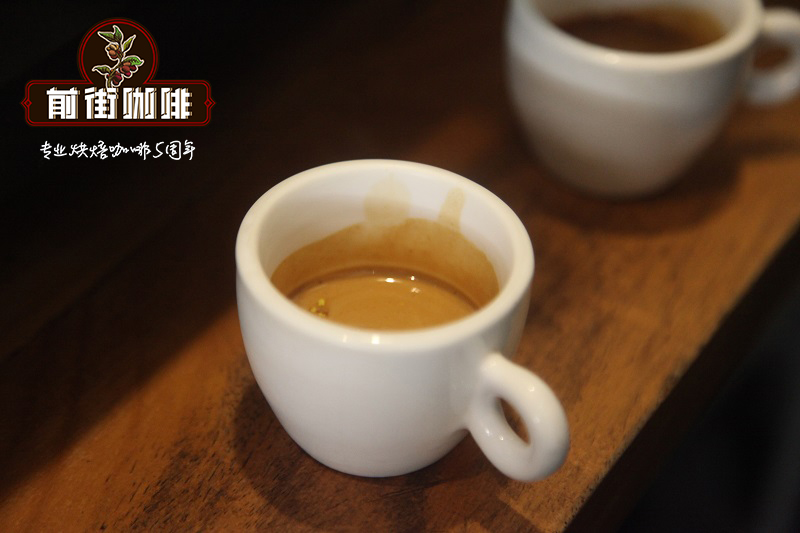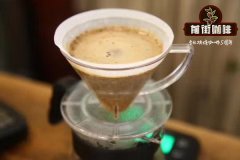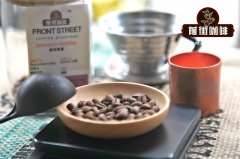How to make espresso | how to taste espresso | the main points of making espresso

Professional coffee knowledge exchange more coffee bean information please follow the coffee workshop (Wechat official account cafe_style)
Espresso is probably the most misunderstood and unpopular way of brewing coffee in a coffee shop. Most people probably think that only severe coffee addicts who pursue excitement or professional coffee tasting masters will choose to drink Espresso. But in fact, in 1901, when Luigi Bezzera first invented the world's first espresso machine, he did not want to "add oil" to coffee addicts, nor to satisfy the elegant enjoyment of literati, he just wanted to make a cup of coffee "quickly". His invention was greatly improved by Achille Gaggia in the 1940s, when the espresso machine was introduced into a manual joystick, and since then, professional Barista-- "handles" were officially born.
For baristas, a cup of Espresso is not only a test of skill, but also a knowledge and love of coffee.
As the base of all espresso, Espresso can be said to support half the sky of the coffee world. An ideal Espresso should be able to strike a balance between the various elements, taste bright, and feel sweet but not bitter in the throat after drinking it. To put it more specifically, it should have moderate sour, bitter, sweet, rich taste, solid and mellow consistency, lasting, and make people feel as refreshing and sour as citrus.
In the World Barista Competition (WBC,World Barista Championship), Italian concentrate (Espresso) needs to meet the following conditions:
a. The capacity of an espresso is 1 ounce (ounce) (25-35ml including fat (crema)).
b. An espresso is extracted from several grams of coffee (the specific number of grams depends on the coffee and the degree of grinding)
c. The water temperature used for extraction is between 90.5 and 96 degrees Celsius (195 to 205 degrees Fahrenheit).
d. The extraction pressure of the Italian coffee machine is 8.5-9.5 atmospheric pressure.
e. The best time for coffee extraction is between 20 and 30 seconds, but there is no mandatory rule
f. For the Italian concentrate used in the same drink, the difference in extraction time must be controlled within 3.0 seconds.
g. Espresso must be served in a 60-90ml (2-3 oz ounce) coffee cup with one ear.
h. The Italian style is condensed into a coffee spoon, paper towel and water when the referee tastes it.
How to identify Espresso
Look at the color of crema, the uniformity of color, thickness, extension, etc.
Smell: caramel, nut, chocolate, etc.
Taste: coffee sweet, sour, mellow, aftertaste, etc., especially pay attention to the Italian concentrated "bittersweet" taste, hierarchy and balance.
Aftertaste: after drinking, feel the feeling of the coffee in the mouth, that is, the aftertaste of the coffee, including how the aroma, taste and so on.
Factors affecting the quality of Espresso
Coffee beans
It is impossible to make a good Espresso without a good mix of coffee beans. Mixed beans must be matched with the sweetness, aroma and lubrication required by Espresso. Coffee beans must be fresh.
Baking
Deeply roasted beans will taste bitter and scorched, and excessive deep roasting will even make the coffee lose most of its flavor, while experienced bakers will use medium and deep roasting to keep the Espresso sweet. Different baking degrees will bring different flavors and need to be matched with different extraction parameters.
Grinding
A high-quality bean grinder must be used to avoid the heat of the grinding plate affecting the flavor of the coffee. The grinding thickness will be related to many factors, such as climate, coffee bean baking degree, freshness, humidity, new and old bean grinder, and so on. There has always been a saying in the industry: "the correct grinding thickness is changing all the time, but the wrong grinding remains the same."
Receive powder and cloth powder
After grinding and before pressing the powder, the coffee powder must be evenly distributed in the powder bowl of the handle.
Filling strength
There are various styles of packing. In this world, almost no two people's packing will be exactly the same. Generally speaking, if it is heavy pressure, the required pressure will be the pressure like 25kg/m2, but packing is actually the freest parameter. The key is to press it smoothly and evenly.
Hydraulic pressure
The modern coffee machine is much more advanced than the old LAVA machine, which is controlled by a water pump to output controllable water pressure. The ideal water pressure of Espresso is generally 9 BAR, which is generally recognized as the most ideal extraction pressure.
Water temperature
The water temperature depends on the needs of different varieties of coffee beans, some are subject to boiler pressure, while others are more flexible and precise. According to the experience of most baristas, the water temperature is between 90 and 92 degrees Celsius, and each barista can adjust flexibly according to his or her own understanding and needs. Of course, you're not actually going to transfer it.
Powder quantity
The amount of Espresso powder for a single serving is 7 to 10 grams of coffee powder, and that for a double serving is 14 to 20 grams, depending on the maximum powder content of the powder bowl and the formula of the coffee shop.
Extraction time
The extraction time of Espresso gold cup extraction is between 20 and 30 seconds, but the extraction time is actually a comprehensive performance of packing pressure, powder amount and grinding degree, which needs to be adjusted by barista's understanding of Espresso.
Extraction quantity
The older term is that Espresso has a single 30ml extract and a double 60ml extract, but its practical electronic scale is more accurate than the volume, because the state of the coffee beans affects the volume of the oil. The specific value depends on the ratio of gouache to powder.
How to adjust the Italian concentrated formula
Adjusting the espresso recipe is a must for every barista before going to work every day. By constantly tasting the coffee and adjusting the grinding degree and gouache ratio of the coffee, the truly satisfactory coffee can be obtained.
Each barista has different preferences for the formula, and each coffee shop has different requirements for the formula. Some people like powder weighing 18 grams and producing 36 grams, while others like powder weighing 18 grams and producing 40 grams. Some people like the extraction time at 25-30 seconds, while others prefer 30-35 seconds. No matter what the formula is, our ultimate goal is to make the coffee taste as expected and achieve the best quality.
The principle of formula adjustment
When adjusting the formula, we often use the following technical terms:
Amount of powder: that is, the amount of coffee powder in the filter bowl.
Product: the amount of coffee in the coffee cup.
Extraction time: the time it takes for water to filter coffee powder, complete the extraction of coffee, and produce quantitative coffee.
Recipe: combine all the above parameters to form the formula that baristas follow when making coffee every day. For example, baristas will tell you, "my recipe is 18 grams of powder, 36 grams of product, and extraction time of 25-30 seconds."
Do you know how to adjust the formula?
For the sake of stable quality and fixed cost, most coffee shops fix the ratio of water to powder (the ratio of powder to product), so in the daily adjustment of the formula, only the degree of grinding is enough.
Why do you need to adjust the grinding?
Only 30% of roasted coffee beans are soluble. In general, the best extraction rate of espresso is about 18-22%.
Then in order to ensure the extraction rate of Italian concentration between 18-22%, we need to adjust the grinding degree to control the speed and time of hot water passing through coffee powder, and finally achieve the purpose of controlling the extraction rate.
Adjust the steps of grinding
Weigh the coffee powder
Let's talk about the amount of powder here. The maximum amount of powder depends on the maximum capacity of the powder bowl-that is, during normal grinding, the powder bowl is connected with powder, scraped flat cloth, the weight of coffee powder, daily production according to the formula, can only be less than the maximum, not more. You ask why? That is the question to be discussed in the next article ~ about the choice of powder bowls, it is recommended to use double powder bowls, the success rate is higher than single powder bowls, the product is more stable.
two。 Measure the total weight of coffee
When adjusting the degree of grinding, the ratio of water to powder should be strictly followed. When the extraction weight is sufficient, the extraction should be stopped. For example, if my amount of powder is 20 grams and the ratio of water to powder is 1:2, then the weight of the whole extract should be 40 grams.
3. Record production time
Remember! From the moment you press the extraction switch of the coffee machine, you should press the timer synchronously and record until the extraction stops turning off the switch. The extraction time of normal extraction should be between 20 seconds and 30 seconds.
How to adjust the degree of grinding
So, when you follow the above formula, steps, how to determine the need and direction of adjustment?
1, please pull up to see: how to taste Italian concentration (Espresso), to put it simply, if the extraction time is too long and the taste is too bitter, the powder is too fine to lead to over-extraction, so make it thicker; if the extraction time is too short and the taste is sour, it is that the powder is too coarse to lead to insufficient extraction, adjust it fine. It is recommended to adjust two fine scales at a time.
2. Under normal extraction conditions, too coarse powder will cause water to flow through the powder bowl too fast, rough water, light extraction, white color, sharp flavor, because the extraction is incomplete, only the acidic substances on the surface and easy to extract are extracted. if the extraction time is long, it will also be over-extracted on the surface, insufficient extraction inside, showing acidity, because of the lack of sweetness, and then bitter and astringent mouth. If the powder is too fine, it will first block the filter hole, the water can not flow out or the water column is too thin, the oil color is dark, the extraction is excessive, the high temperature and high pressure are all contained in the powder bowl, bitter, mixed, and there are all kinds of good and bad flavors.
3. Finally, we have to mention the problem of uneven extraction. It is caused by uneven cloth powder, crooked pressing powder, cracks in pressed powder, uneven grinding of coffee beans, too much ultra-fine powder and so on. The performance is that the flavor is messy, bitter and bitter, and the flavor is a bit like that of fine powder, but the flow rate and color are different. If the powder is too coarse, and then lengthen the extraction time, it is a kind of uneven extraction, so if the powder is coarse, it is not only acid, but also depends on the extraction time.
4, when you are in the extraction of Espresso, if the flow rate suddenly increases, there is uneven color of oil (crema), that is, pressed powder perforation, resulting in a "channel effect", the "channel effect" will make the flow more easily through the cracks in pressed powder and not compacted, causing uneven coffee extraction, getting a cup of bad Espresso. The common reasons are uneven cloth powder, uneven force when pressing powder, or too much powder (too much coffee powder). Go back to practice your basic skills, Sao Nian.
Remember, Espresso is like a magnifying glass that highlights some of the flavor features of coffee. The flavor of Espresso may seem intense and exciting at first, but as you keep tasting it, you will get used to it and fall in love with it uncontrollably-as long as you make it good!
End
Important Notice :
前街咖啡 FrontStreet Coffee has moved to new addredd:
FrontStreet Coffee Address: 315,Donghua East Road,GuangZhou
Tel:020 38364473
- Prev

What kind of water is suitable for brewing coffee? what is the effect of different water on coffee?
Professional coffee knowledge exchange more information about coffee beans Please pay attention to the PH value of water in the coffee shop (Wechat official account cafe_style). The PH value refers to the strength of acidity and alkalinity in the aqueous solution. When the water is at 25 ℃, a PH value of 7 means neutral, a PH value greater than 7 indicates a stronger alkalinity, and a PH value less than 7 indicates a stronger acidity. The stronger the alkalinity, the stronger the ability to counteract the acid; the stronger the acidity, the stronger the acid.
- Next

Introduction to Arabica coffee beans | is the flavor and taste of Arabica coffee beans good
Professional coffee knowledge exchange more coffee bean information please follow the coffee workshop (Wechat official account cafe_style) Arabica coffee is the most used coffee beans in the coffee market, accounting for 70% of the coffee market, the so-called mobile phone of the coffee industry. Because Arabica is grown at high altitude, it has high nutrient absorption, abundant precipitation and slow ripening, so both aroma and taste
Related
- Beginners will see the "Coffee pull flower" guide!
- What is the difference between ice blog purified milk and ordinary milk coffee?
- Why is the Philippines the largest producer of crops in Liberia?
- For coffee extraction, should the fine powder be retained?
- How does extracted espresso fill pressed powder? How much strength does it take to press the powder?
- How to make jasmine cold extract coffee? Is the jasmine + latte good?
- Will this little toy really make the coffee taste better? How does Lily Drip affect coffee extraction?
- Will the action of slapping the filter cup also affect coffee extraction?
- What's the difference between powder-to-water ratio and powder-to-liquid ratio?
- What is the Ethiopian local species? What does it have to do with Heirloom native species?

